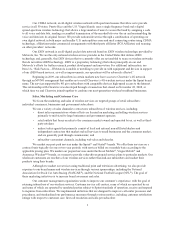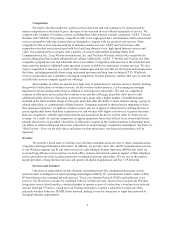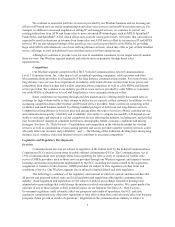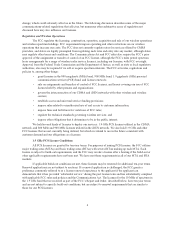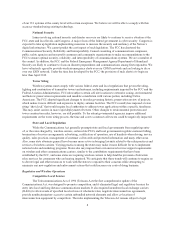Sprint - Nextel 2008 Annual Report Download - page 13
Download and view the complete annual report
Please find page 13 of the 2008 Sprint - Nextel annual report below. You can navigate through the pages in the report by either clicking on the pages listed below, or by using the keyword search tool below to find specific information within the annual report.profits. The FCC is considering the legality of traffic pumping arrangements as well as rule changes to ensure
that rates charged by LECs experiencing substantial increases in demand volumes are just and reasonable. As a
major wireless and wireline carrier, we have been assessed millions of dollars in access charges for “pumped”
traffic. Adoption by the FCC of measures to limit the windfall profits associated with traffic pumping would have
a direct beneficial impact on us. Recent positive decisions against several LECs and their traffic pumping
partners in U.S. district courts and before the Iowa Utilities Board and the FCC may result in some decrease in
this activity.
Universal Service Reform
Communications carriers contribute to and receive support from various universal service funds
established by the FCC and many states. The federal USF program funds services provided in high-cost areas,
reduced-rate services to low-income consumers, and discounted communications and Internet services for
schools, libraries and rural health care facilities. The USF is funded from assessments on communications
providers, including our Wireless and Wireline segments, based on FCC-prescribed contribution factors
applicable to our interstate and international end-user revenues from telecommunications services and
interconnected VoIP services. Similarly, many states have established their own universal service funds to which
we contribute. The FCC is considering changing the interstate revenue-based assessment with an assessment
based on telephone numbers or connections to the public network, which could impact the amount of our
assessments, but it is not clear that the FCC is prepared to take action in the near future. As permitted, we assess
subscribers for these USF charges.
The FCC also is considering changing the way it distributes federal USF support to competitive carriers
like us. Currently, we receive support in 25 jurisdictions as an Eligible Telecommunications Carrier (ETC). In
2008, the FCC capped the total amount of high cost USF support competitive carriers could receive and has
continued to impose conditions on parties seeking merger or acquisition approval to reduce their USF receipts.
As part of the Clearwire transaction, we agreed to reduce our USF receipts to zero in five equal steps over a four
year-period. The annual amount we currently receive from USF is immaterial. In addition, various state
commissions have imposed or are considering new billing, Lifeline service and network deployment
requirements which add significantly to the cost and burden of providing service as an ETC. A loss of our ETC
designation in a given state, whether voluntary or mandatory, would require us to forego our USF support in that
state.
Electronic Surveillance Obligations
The CALEA requires telecommunications carriers, including us, to modify equipment, facilities and
services to allow for authorized electronic surveillance based on either industry or FCC standards. Our CALEA
obligations have been extended to data and VoIP networks, and we are in compliance with these requirements.
Certain laws and regulations require that we assist various government agencies with electronic surveillance of
communications and records concerning those communications. We are a defendant in four purported class
action lawsuits that allege that we participated in a program of intelligence gathering activities for the federal
government following the terrorist attacks of September 11, 2001 that violated federal and state law. Relief
sought in these cases includes injunctive relief, statutory and punitive damages, and attorneys’ fees. We believe
these suits have no merit, and they were dismissed by the district court. The plaintiffs’ appeal to the US Court of
Appeals for the Ninth Circuit is pending. We do not disclose customer information to the government or assist
government agencies in electronic surveillance unless we have been provided a lawful request for such
information.
Privacy-Related Regulations
We comply with FCC customer proprietary network information (CPNI) rules, which require carriers to
comply with a range of marketing and safeguard obligations. These obligations focus on carriers’ access, use,
storage and disclosure of CPNI. In 2007, the FCC adopted a new CPNI Order that imposed additional CPNI
obligations on carriers. The new CPNI rules took effect in December 2007. We are utilizing a variety of
compliance vehicles, such as technical and systematic solutions and updated policies and procedures, to conform
our operations to the new CPNI obligations. The technical and systematic solutions offer significant data security
11




